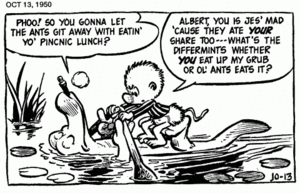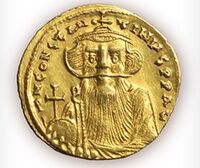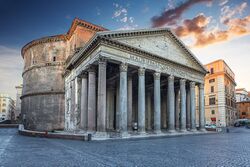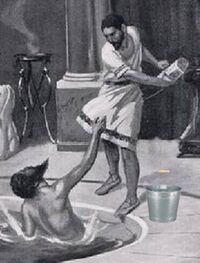Constans II
Constans II was the Byzantine Emperor from 641 to 668. However, his name was Herakleios. However, his name was called Constantine. However, Constans II himself was called Pogonatos (Πωγωνάτος), once he grew old enough to grow facial hair like the famous cartoon rodent, Pogo.
The name Constans has become standard with modern historians. No one in the 7th century actually called him Constans, as the 11-year-old was too young to be constant, or probably even continent. His reign was not over in mere months, as were those of "the other kids." It was interrupted by several attempts to overthrow him, but each backfired with hilarious pratfalls.
Early lives[edit]
In our last episode, the Byzantine Empire had two young co-emperors; Constantine III was 28 years old and Heraklonas was 15. The former died of food poisoning, or tuberculosis, or something; and the latter picked Constans as co-emperor despite being only 11, just for being the coolest kid on the playground. This nomination was in the nick of time, as Heraklonas was about to be sent away without his nose, leaving the pre-teen as the sole emperor.
Byzantium found that these rulers did not have the wisdom of their years, much less the wisdom of the sum-of-the-years. However, Constans was lucky to have a group of Senators, led by patriarch Rand Paul II (R-Constantinople), who would tell him what decrees to make and whose heads to lop off.
Army manages to lose slowly[edit]
It was an awful age to be a Byzantine Emperor — not that 11 is a good age to be one. Kyros, in the Holy See at Alexandria, would See only to negotiate with the Arabs which furniture and appliances the Byzantines would be leaving in Egypt as they moved out. There is no way for an Emperor to poll well when you are re-drawing the map of the nation with no instrument but scissors. Indeed, in 642, Constans said "Holy Shee!" and vacated Alexandria itself. He got it back in 645 but only for a year.
The Arabs next captured Cappadocia, Phrygia, and Amorium, thus assembling all the spices one needs to make spanakopita. There seemed to be no limit to what the Arabs could conquer — well, only one, big and wet. The Arabs began building ships and successfully attacked island resorts, such as the big one on Gypsum. They were encouraged by this victory and went after the Cretins.
Meanwhile, worse turned to just awful, as Cartilege rebelled. Its Exarch (Governor), Gregory the Patsy, had had enough of the Monothelitism imposed by the Emperors. Constans tried hard to straddle the theological fence between the new "Monotheism Lite" and Orthodoxy, refusing to persecute either nor to say what the exact nature of Jesus Christ was. This shilly-shallying only pissed off everyone. Gregory actually declared himself Emperor, but his rule was brief; in Gregory's quest for "a little old-time religion," his city fell to the Arabs and everyone got a dogma even less to their liking. To add insult to injury, in 647, the Arabs killed him.
It seemed that everyone was about to write Greek from right-to-left. However, by 655, the Byzantines had ships of their own, and confronted the Arabs at Phoenix. Rather than rising like the Phoenix, though, they were chased off like the seagulls. The Byzantines lost 500 ships, and Constans lost his imperial robe, finding a naïve midshipman who wanted to try it on while Constans fled with the enlistees and the lucky man got strung up by the invaders.
The Arabs trained their sights on Constantinople itself — but then they started to bicker. Before long, a full-fledged civil war (the first "Planet Fitness") broke out. The Governor of Syria, Muawiyah, saw that he had more on his hands than Byzantines, and signed a truce that let Constans focus on the Balkans, defeating the Slavs. Constans even got news of a rebellion in Media and took the opportunity to sack several copy-editors. Finally, military matters settled down, letting Constans try again to square the circle of Christian doctrine.
Popes gone wild[edit]

Rome had undergone centuries of decay in religious learning, but now acquired great minds like Maximus the Conifer, who pined to Pope Theodore I in 646 for a major-league religious debate.
In 648, Constans prohibited any discussion of whether Christ had "one will and one energy, or two energies and two wills," a subject on which everyone needed clarity. The seventeen-year-old Emperor went further and forbade any talk about the need for a talk. Just, zip it. Fatefully, though, his decree contained a number of Typos, which only made the clergy more convinced to hold a Council and hire a spelling checker. It was to be more than a mere meeting: an ecumenical council, the "sixth synod" of the Christian church, God himself was invited. This was remarkable; even popes had always conceded that only the emperor could convene such a meeting. When they held synods, they always took care to claim they were "only discussing laundry duties and such."
Meeting planning hit a hitch when Pope Theodore I died in 649. The clergy now needed to find a successor who would play along with a Council and yet get Constans to consecrate him. Ultimately, they turned a deacon into Pope Martin I and didn't even ask Constans.
Constans put his foot down, ordering the Exarch of Ravenna to "arrest that Pope!" Olympius demurred, saying he had lost the index card from which to read the Pope his rights. Then Olympius became the latest citizen to declare himself Emperor in place of Constans. In 652, this administration ended with Olympius's death. The next Exarch, Theodore I, put the 'cuffs on the Pope in 653. The Pope was condemned as a criminal and exiled to the Crimea, the Church breaking further with precedent and electing a new Pope before the old one could finish dying. Maximus himself was minimized, Constans removing both his tongue and right hand trying to get him to recant.
Constans had a kid brother, Theodosius, who was increasingly seeming like Emperor material. Constans removed this threat, too, by making Theodosius become a monk, and in 660, making him become a corpse.
Everyone is sick of you[edit]
As the citizens of Constantinople grew tired of Constans, he went away, leaving co-emperor Constantine IV on the throne. Constans ultimately planned to govern remotely from Syracuse, New York. The ostensible reason for this was to beef up Italian defenses against a naval invasion by the Arabs, but in reality, he simply had a favorite truck stop on the Thruway. Along the way, he fought the Slavs, and tried to besiege the Lombards. He got to Rome in 663 and was honored by Pope Vitalian, but managed to piss everyone there off as well, mostly by stripping buildings of their bronze (to be carried back to Constantinople), dissing the Pope, and demanding other payments and tributes.
Demise[edit]
Constantinople got word that, although trinkets were trickling back to the capital, Constans did not intend to follow. He remained in Sicily, replacing his guards with the local Mafia. Constans felt more secure, and much cleaner with a private bath house, despite its tendency to scald him from time to time. An unnamed chamberlain arrived to work on the problem, carrying an ice bucket. No one witnessed what happened next, but a few hours later, the chamberlain had disappeared and Constans was lying dead in his bath with a bucket rammed firmly on his head. The clues were all there, but this round of Cluedo had no winner. Unwillingly, Constans's body was eventually returned to Constantinople for burial.
Constans's son Constantine IV became the next emperor at the age of 37. The city signaled its acceptance of the new emperor with business as usual (a token usurpation): Armenian General Mezizios took the opportunity to announce that he was in charge. Presently, Exarch Gregory arrived and forcefully explained that Mezizios was not. Constantinople became a "loozah without a Mezizzah."
| Preceded by: Constantine III and Heraklonas |
Byzantine Emperor 641–668 |
Succeeded by: Constantine IV |






